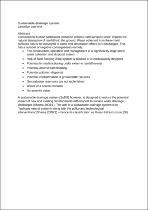JavaScript is disabled for your browser. Some features of this site may not work without it.
- ResearchSpace
- →
- Research Publications/Outputs
- →
- Book Chapters
- →
- View Item
| dc.contributor.author |
Van Wyk, Llewellyn V

|
|
| dc.date.accessioned | 2017-12-14T11:58:18Z | |
| dc.date.available | 2017-12-14T11:58:18Z | |
| dc.date.issued | 2015-10 | |
| dc.identifier.citation | Van Wyk, L.V. 2015. Sustainable drainage system. The Sustainable Infrastructure Handbook SA Volume 2: The Essential Guide, pp 32-40. | en_US |
| dc.identifier.isbn | 978-0-620-63515-8 | |
| dc.identifier.uri | http://hdl.handle.net/10204/9870 | |
| dc.description | Copyright: 2015 Alive2Green. Due to copyright restrictions, the attached PDF file only contains the abstract of the full text item. For access to the full text item, kindly consult the publisher's website. | en_US |
| dc.description.abstract | Conventional human settlement formation creates hard surfaces which impede the natural absorption of rainfall into the ground. Water collected from these hard surfaces has to be conveyed to some end destination where it is discharged. This has a number of negative consequences namely: The construction, operation and management of a significantly large storm water collection and disposal system Risk of flash flooding if the system is blocked or is inadequately designed Potential for malfunctioning under extreme rainfall events Potential downstream flooding Potential pollution dispersal Potential contamination of groundwater sources Groundwater reservoirs are not replenished Waste of a scarce resource No amenity value A sustainable drainage system (SuDS) however, is designed to reduce the potential impact of new and existing developments with respect to surface water drainage discharges (Shama 2008:1). The aim of a sustainable drainage system is to “replicate natural systems along with the policy and technological interventions”(Shama 2008:2) – hence its classification as Green Infrastructure (GI). | en_US |
| dc.language.iso | en | en_US |
| dc.relation.ispartofseries | Worklist;16589 | |
| dc.subject | Sustainable drainage systems | en_US |
| dc.subject | Human settlements | en_US |
| dc.subject | Downstream flooding | en_US |
| dc.subject | Groundwater reservoirs | en_US |
| dc.title | Sustainable drainage system | en_US |
| dc.type | Book Chapter | en_US |
| dc.identifier.apacitation | Van Wyk, L. V. (2015). Sustainable drainage system., <i>Worklist;16589</i> http://hdl.handle.net/10204/9870 | en_ZA |
| dc.identifier.chicagocitation | Van Wyk, Llewellyn V. "Sustainable drainage system" In <i>WORKLIST;16589</i>, n.p.: n.p. 2015. http://hdl.handle.net/10204/9870. | en_ZA |
| dc.identifier.vancouvercitation | Van Wyk LV. Sustainable drainage system.. Worklist;16589. [place unknown]: [publisher unknown]; 2015. [cited yyyy month dd]. http://hdl.handle.net/10204/9870. | en_ZA |
| dc.identifier.ris | TY - Book Chapter AU - Van Wyk, Llewellyn V AB - Conventional human settlement formation creates hard surfaces which impede the natural absorption of rainfall into the ground. Water collected from these hard surfaces has to be conveyed to some end destination where it is discharged. This has a number of negative consequences namely: The construction, operation and management of a significantly large storm water collection and disposal system Risk of flash flooding if the system is blocked or is inadequately designed Potential for malfunctioning under extreme rainfall events Potential downstream flooding Potential pollution dispersal Potential contamination of groundwater sources Groundwater reservoirs are not replenished Waste of a scarce resource No amenity value A sustainable drainage system (SuDS) however, is designed to reduce the potential impact of new and existing developments with respect to surface water drainage discharges (Shama 2008:1). The aim of a sustainable drainage system is to “replicate natural systems along with the policy and technological interventions”(Shama 2008:2) – hence its classification as Green Infrastructure (GI). DA - 2015-10 DB - ResearchSpace DP - CSIR KW - Sustainable drainage systems KW - Human settlements KW - Downstream flooding KW - Groundwater reservoirs LK - https://researchspace.csir.co.za PY - 2015 SM - 978-0-620-63515-8 T1 - Sustainable drainage system TI - Sustainable drainage system UR - http://hdl.handle.net/10204/9870 ER - | en_ZA |






